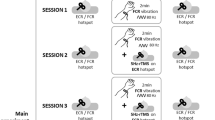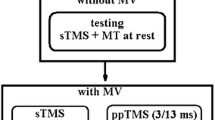Abstract
Changes in afferent input can alter the excitability of intracortical inhibitory systems. For example, using paired transcranial magnetic stimulation (TMS), both electrical digital stimulation and muscle vibration have been shown to reduce short-interval intracortical inhibition (SICI). The effects following muscle vibration are confined to the corticospinal projection to the vibrated muscles. The results following digital stimulation are less clear and the relative timing of the cutaneous stimulation and TMS is critical. Here we investigated further whether changes in SICI following digit stimulation exhibit topographic specificity. Eleven normal subjects were investigated (age 28.2±7.5 years, mean±SD). Electromyographic recordings were made from the right first dorsal interosseous (FDI), abductor digiti minimi (ADM) and abductor pollicis brevis (APB) muscles. SICI was measured, with and without preceding electrical digit II or digit V cutaneous stimulation. The interval between the digital nerve stimulus and test magnetic stimulus was independently set for each subject and established by subtracting the onset latency of the motor evoked potential (MEP) from the latency of the E2 component of the cutaneomuscular reflex. Therefore, measures of intracortical excitability were made at a time at which it is known that cutaneous input is capable of modulating cortical excitability. Single digital nerve stimuli applied to digit II significantly reduced SICI in FDI but not in ADM. Single digital nerve stimuli applied to digit V significantly reduced SICI in ADM but not in FDI or APB. There was a more generalised effect on intracortical facilitation (ICF) with both digit II and digit V stimulation significantly increasing ICF in FDI and ADM. Digital stimulation (either DII or DV) did not significantly affect SICI/ICF in APB. These findings show that appropriately timed cutaneous stimuli are capable of modulating SICI in a topographically specific manner. We suggest that the selective decrease in SICI seen with cutaneous stimulation may be important for focusing of muscle activation during motor tasks.



Similar content being viewed by others
References
Caccia NR, McComas AJ, Upton ARM, Blogg T (1973) Cutaneous reflexes in small muscles of the hand. J Neurol Neurosurg Psychiatr 36:960–977
Classen J, Steinfelder B, Liepert J, Stefan K, Celnik P, Cohen LG, Hess A, Kunesch E, Chen R, Benecke R, Hallett M (2000) Cutaneomotor integration in humans is somatotopically organized at various levels of the nervous system and is task dependent. Exp Brain Res. 130:48–59
Fisher RJ, Nakamura Y, Bestmann S, Rothwell JC, Bostock H (2002) Two phases of intracortical inhibition revealed by transcranial magnetic threshold tracking. Exp Brain Res 143:240–248
Jenner JR, Stephens JA (1982) Cutaneous reflex responses and their central nervous pathways studied in man. J Physiol (Lond) 333:405–419
Kobayashi M, Ng J, Theoret H, Pascual-Leone A (2003) Modulation of intracortical neuronal circuits in human hand motor area by digit stimulation. Exp Brain Res 149:1–8
Kujirai T, Caramia MD, Rothwell JC, Day BL, Thompson PD, Ferbert A, Wroe S, Asselman P, Marsden CD (1993) Corticocortical inhibition in human motor cortex. J Physiol (Lond) 471:501–519
Lemon RN (1981) Functional properties of monkey motor cortex neurones receiving afferent input from the hand and fingers. J Physiol (Lond) 311:497–519
Maertens de Noordhout A, Rothwell JC, Day BL, Dressler D, Nakashima K, Thompson PD, Marsden CD (1992) Effect of digital nerve stimuli on responses to electrical or magnetic stimulation of the human brain. J Physiol (Lond) 447:535–548
Muellbacher W, Ziemann U, Boroojerdi B, Cohen L, Hallett M (2001) Role of the human motor cortex in rapid motor learning. Exp Brain Res 136:431–438
Ridding MC, Inzelberg R, Rothwell JC (1995a) Changes in excitability of motor cortical circuitry in patients with Parkinson’s disease. Ann Neurol 37:181–188
Ridding MC, Rothwell JC (1999) Afferent input and cortical organisation: a study with magnetic stimulation. Exp Brain Res 126:536–544
Ridding MC, Sheean G, Rothwell JC, Inzelberg R, Kujirai T (1995b) Changes in the balance between motor cortical excitation and inhibition in focal, task specific dystonia. J Neurol Neurosurg Psychiatr 59:493–498
Ridding MC, Taylor JL, Rothwell JC (1995c) The effect of voluntary contraction on cortico-cortical inhibition in human motor cortex. J Physiol (Lond) 487:541–548
Rosenkranz K, Pesenti A, Paulus W, Tergau F (2003) Focal reduction of intracortical inhibition in the motor cortex by selective proprioceptive stimulation. Exp Brain Res 149:9–16
Rosenkranz K, Rothwell JC (2003) Differential effect of muscle vibration on intracortical inhibitory circuits in humans. J Physiol 551:649–660
Stinear CM, Byblow WD (2003) Role of intracortical inhibition in selective hand muscle activation. J Neurophysiol 89:2014–2020
Stinear CM, Byblow WD (2004) Impaired modulation of intracortical inhibition in focal hand dystonia. Cereb Cortex 14:555–561
Tamburin S, Manganotti P, Zanette G, Fiaschi A (2001) Cutaneomotor integration in human hand motor areas: somatotopic effect and interaction of afferents. Exp Brain Res 141:232–241
Ziemann U, Chen R, Cohen LG, Hallett M (1998) Dextromethorphan decreases the excitability of the human motor cortex. Neurology 51:1320–1324
Ziemann U, Lönnecker S, Paulus W (1995) Inhibition of human motor cortex by ethanol. A transcranial magnetic stimulation study. Brain 118:1437–1446
Ziemann U, Lönnecker S, Steinhoff BJ, Paulus W (1996) Effects of antiepileptic drugs on motor cortex excitability in humans: a transcranial magnetic stimulation study [see comments]. Ann Neurol 40:367–378
Zoghi M, Pearce SL, Nordstrom MA (2003) Differential modulation of intracortical inhibition in human motor cortex during selective activation of an intrinsic hand muscle. J Physiol 550:933–946
Acknowledgements
This work is supported by grants from the Australian Research Council and National Health and Medical Research Council of Australia. MCR holds a Queen Elizabeth II Fellowship from the Australian Research Council.
Author information
Authors and Affiliations
Corresponding author
Rights and permissions
About this article
Cite this article
Ridding, M.C., Pearce, S.L. & Flavel, S.C. Modulation of intracortical excitability in human hand motor areas. The effect of cutaneous stimulation and its topographical arrangement. Exp Brain Res 163, 335–343 (2005). https://doi.org/10.1007/s00221-004-2176-7
Received:
Accepted:
Published:
Issue Date:
DOI: https://doi.org/10.1007/s00221-004-2176-7




